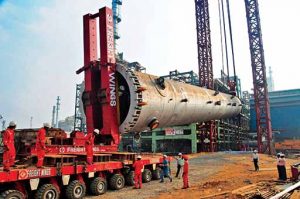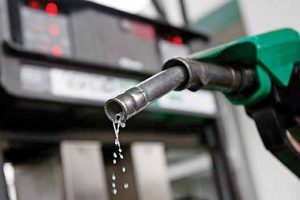Chennai Petroleum Corporation Ltd. (CPCL) has announced the supply of BSVI fuels starting September 2019.
Story by:
Bhargav TS
A subsidiary of Indian Oil Corporation (IOC), Chennai Petroleum Corporation Ltd. (CPCL) has planned a capex of Rs.1000 crore for various projects, including the development of BSVI fuels. Planning to set up a nine-million tonne refinery at Cauvery Basin, Nagapattinam in Tamil Nadu, at a cost of Rs.27,400 crore, CPCL will use a portion of Rs.1000 crore capex to install a new crude oil pipeline and execute a re-gassified liquefied natural gas project. To meet the demand
 for cleaner fuel by April 2020, CPCL, along with other oil marketing companies (OMCs) has decided to speed up the process of upgrading its refinery. Announced Sanjiv Singh, Chairman, Indian Oil Corporation (IOC), “To meet Bharat Stage VI (BSVI) emission standards, the process could throw up some challenges. We are however speeding up the process by enhancing our Manali refinery in Chennai and will start supplying BSVI fuels by September 2019.” S N Pandey, Managing Director, CPCL, expressed, “Approval has been obtained for the new projects and preparation of a detailed feasibility report is on. It is expected to be completed by March 2019, and the cost could be plus or minus 30 per cent.” “CPCL might go to the market to raise funds for the new refinery,” he added.
for cleaner fuel by April 2020, CPCL, along with other oil marketing companies (OMCs) has decided to speed up the process of upgrading its refinery. Announced Sanjiv Singh, Chairman, Indian Oil Corporation (IOC), “To meet Bharat Stage VI (BSVI) emission standards, the process could throw up some challenges. We are however speeding up the process by enhancing our Manali refinery in Chennai and will start supplying BSVI fuels by September 2019.” S N Pandey, Managing Director, CPCL, expressed, “Approval has been obtained for the new projects and preparation of a detailed feasibility report is on. It is expected to be completed by March 2019, and the cost could be plus or minus 30 per cent.” “CPCL might go to the market to raise funds for the new refinery,” he added.
Investing over Rs.80,000 crore to upgrade the quality of petrol and diesel to meet BSVI specifications by 2020, oil companies, most of which are government owned, have been supplying BSIV fuels across the country ever since the emission standards came in April 2017. The Supreme Court order to stop the sale of BSIII vehicles inflicted pain on many CV makers as they had to deal with significant BSIII inventory. With the BSIV shock behind them, CV makers are striving to develop technologies to meet BSVI emission norms by 2020. The challenge of developing BSVI technologies lies in their ability to be offer them at Indian costs, and in ones that will reliably work in Indian conditions, CV makers are claimed to be pulling all the stops to achieve success. To be able to test BSVI technologies they are also looking at an early availability to BSVI fuel.
The basic difference between BSIV and BSVI fuel is in the sulphur content. BSVI fuels will have far lower sulphur content than BSIV. In the case of diesel fuel, the sulphur content would be 10 parts per million (ppm) in BSVI versus 350 ppm in BSIII and 50 ppm in BSIV. Taking seven years to graduate from BSIII to BSIV, the move u to BSVI from BSIV has had a narrow timeline of three years. Bypassing BSV emission standards, the timeline for the introduction of BSVI standards was brought down to 2020 by the government from 2024.
 Claimed to have been done in-line with India’s commitment at the 2015 Paris Climate Change conference to combat climate change, the country, as per the agreement, would reduce carbon footprint by 33 to 35 per cent by 2030 from the 2005 levels. Averred Singh, “We have different processes, where we have seven to eight different streams of diesel. In these streams, there are different quantities of sulphur. It is 10 ppm in some; zero in some, and 500 ppm in others. We mix them in different ratios and add properties to make the final diesel components.” “When we make diesel with 50 ppm, or petrol with 10 ppm, all the streams will have to be further hydro-treated. We have to take out the sulphur from all the streams. Hydro-treatment is an established refinery process for reducing sulphur and nitrogen,” he added.
Claimed to have been done in-line with India’s commitment at the 2015 Paris Climate Change conference to combat climate change, the country, as per the agreement, would reduce carbon footprint by 33 to 35 per cent by 2030 from the 2005 levels. Averred Singh, “We have different processes, where we have seven to eight different streams of diesel. In these streams, there are different quantities of sulphur. It is 10 ppm in some; zero in some, and 500 ppm in others. We mix them in different ratios and add properties to make the final diesel components.” “When we make diesel with 50 ppm, or petrol with 10 ppm, all the streams will have to be further hydro-treated. We have to take out the sulphur from all the streams. Hydro-treatment is an established refinery process for reducing sulphur and nitrogen,” he added.
According to an expert, the Research Octane Number (RON) is one of the most critical specifications for petrol engines. It has improved from 88 (in BSII) to 91, which is on par with regular 91 octane gasoline required for Euro6 emission norms. Other critical specifications involving benzene and aromatics have also undergone considerable improvement from earlier limits specified in BSII, he stated. Despite the demand for Octane 95 petrol rising quickly, Euro6 specifications call for retention of Octane 91 or Octane 96. OEMs prefer Octane 95 to 91 because it provides engine with more power. “Putting Octane 95 in cars running on Octane 91 engines brings no benefits, the expert opined. He said that this is one instance of the pushbacks from auto and the oil industries that will be rife in 2019. The issue of whether BSVi fuels will be offered from a different dispenser is yet to be clear. For the quarter ended March 2018, CPCL reported a net profit of Rs 1.78 billion against Rs 1.71 billion in the previous quarter. The improvement in the profit was due to better physical performance and favourable product racks resulting in an increase in gross refining margin to USD 6.42 a barrel from USD 6.05.

























